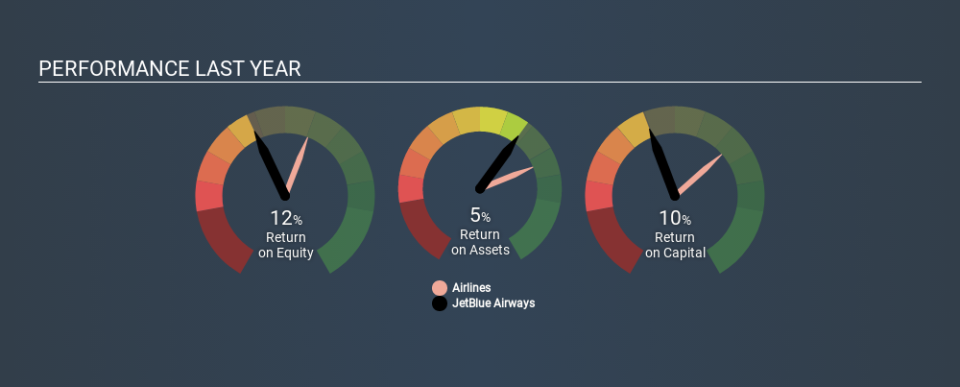Are JetBlue Airways Corporation’s (NASDAQ:JBLU) Returns On Investment Worth Your While?

Today we are going to look at JetBlue Airways Corporation (NASDAQ:JBLU) to see whether it might be an attractive investment prospect. In particular, we'll consider its Return On Capital Employed (ROCE), as that can give us insight into how profitably the company is able to employ capital in its business.
Firstly, we'll go over how we calculate ROCE. Second, we'll look at its ROCE compared to similar companies. Last but not least, we'll look at what impact its current liabilities have on its ROCE.
Understanding Return On Capital Employed (ROCE)
ROCE is a metric for evaluating how much pre-tax income (in percentage terms) a company earns on the capital invested in its business. All else being equal, a better business will have a higher ROCE. Ultimately, it is a useful but imperfect metric. Renowned investment researcher Michael Mauboussin has suggested that a high ROCE can indicate that 'one dollar invested in the company generates value of more than one dollar'.
How Do You Calculate Return On Capital Employed?
The formula for calculating the return on capital employed is:
Return on Capital Employed = Earnings Before Interest and Tax (EBIT) ÷ (Total Assets - Current Liabilities)
Or for JetBlue Airways:
0.095 = US$814m ÷ (US$11b - US$2.8b) (Based on the trailing twelve months to December 2019.)
So, JetBlue Airways has an ROCE of 9.5%.
See our latest analysis for JetBlue Airways
Does JetBlue Airways Have A Good ROCE?
ROCE is commonly used for comparing the performance of similar businesses. It appears that JetBlue Airways's ROCE is fairly close to the Airlines industry average of 11%. Aside from the industry comparison, JetBlue Airways's ROCE is mediocre in absolute terms, considering the risk of investing in stocks versus the safety of a bank account. It is possible that there are more rewarding investments out there.
JetBlue Airways's current ROCE of 9.5% is lower than 3 years ago, when the company reported a 18% ROCE. So investors might consider if it has had issues recently. The image below shows how JetBlue Airways's ROCE compares to its industry, and you can click it to see more detail on its past growth.
When considering this metric, keep in mind that it is backwards looking, and not necessarily predictive. Companies in cyclical industries can be difficult to understand using ROCE, as returns typically look high during boom times, and low during busts. ROCE is only a point-in-time measure. Since the future is so important for investors, you should check out our free report on analyst forecasts for JetBlue Airways.
JetBlue Airways's Current Liabilities And Their Impact On Its ROCE
Current liabilities are short term bills and invoices that need to be paid in 12 months or less. Due to the way the ROCE equation works, having large bills due in the near term can make it look as though a company has less capital employed, and thus a higher ROCE than usual. To check the impact of this, we calculate if a company has high current liabilities relative to its total assets.
JetBlue Airways has total assets of US$11b and current liabilities of US$2.8b. Therefore its current liabilities are equivalent to approximately 24% of its total assets. This is a modest level of current liabilities, which would only have a small effect on ROCE.
What We Can Learn From JetBlue Airways's ROCE
With that in mind, we're not overly impressed with JetBlue Airways's ROCE, so it may not be the most appealing prospect. But note: make sure you look for a great company, not just the first idea you come across. So take a peek at this free list of interesting companies with strong recent earnings growth (and a P/E ratio below 20).
If you like to buy stocks alongside management, then you might just love this free list of companies. (Hint: insiders have been buying them).
If you spot an error that warrants correction, please contact the editor at editorial-team@simplywallst.com. This article by Simply Wall St is general in nature. It does not constitute a recommendation to buy or sell any stock, and does not take account of your objectives, or your financial situation. Simply Wall St has no position in the stocks mentioned.
We aim to bring you long-term focused research analysis driven by fundamental data. Note that our analysis may not factor in the latest price-sensitive company announcements or qualitative material. Thank you for reading.

 Yahoo Finance
Yahoo Finance 
